Before she landed in the hospital, Wilma Jones (not her real name) was living independently and generally managing well, despite some mild cognitive impairment. But one day, when an insurance assessor came to her home, Jones answered in her underwear, in a state of confusion, and fell.
Hospital staff determined that Jones, in her late 80s, was taking two medications for insomnia: clonazepam (Klonopin), prescribed by her physician, along with Advil PM, an over-the-counter (OTC) medication she had self-prescribed.
“The combination of these medications had a significant effect on her cognition and her ability to maintain safety, causing her to fall multiple times,” said Katie Pescatello, a nurse practitioner and hospitalist who helped care for Jones. “After those medications were removed, she returned to her normal cognitive status.”
Jones’s ordeal is far from rare. As many as one-third of emergency hospital admissions among people 75 or older may be in part due to medication-related problems. Those with cognitive impairment are especially vulnerable.
To help address the problem, the Journal of the American Geriatrics Society (AGS) maintains the Beers Criteria, a directory of drugs that are potentially harmful for older adults. In July 2025, the AGS published new recommendations for treating common symptoms affecting older adults that list alternative medications as well as nonpharmacological treatments.
But many patients and caregivers aren’t aware of the Beers Criteria—or that it includes common OTC medications that many older adults self-prescribe.
“People assume they’re benign, but over-the-counter medications can be very harmful, depending on your age, your concurrent medications, and your kidney and liver function,” said Dominick Trombetta, PharmD, associate professor at Wilkes University School of Pharmacy in Wilkes-Barre, PA.
The Beers Criteria was developed in 1991 by the late Mark Beers, MD, and colleagues, originally as a guide to prevent improper use of medications in nursing home settings. The list gained popularity and was eventually expanded to include all older adults. The AGS has maintained the Beers Criteria since 2011 with periodic updates, most recently in 2023.
Until recently, the Beers Criteria only flagged drugs whose potential for harm outweighed their intended benefits. A panel of experts would hammer out specific recommendations to guide physicians in handling common conditions that affect older adults and are often treated with Beers Criteria medications, including allergic rhinitis, pruritus (itching), pain, diabetes, involuntary weight loss, atrial fibrillation (Afib), anxiety, insomnia, delirium, gastroesophageal reflux (GERD) and recurrent urinary tract infections.
The current publication also recommends alternative medications and nonpharmacological interventions, such as cognitive behavioral therapy for sleeplessness, or exercise, physical therapy and psychological interventions for pain.
Problematic OTC Medications
Among the most common OTC medications on the list are sedating antihistamines, including Benadryl (diphenhydramine), Unisom (doxylamine) and Bonine/Dramamine (meclizine). These medications are used to treat allergies or to aid with sleep, since they cause drowsiness in many patients. (They are sometimes called “first-generation” antihistamines, distinguishing them from second- and third-generation antihistamines, which are less likely to cause sleepiness and less likely to cause interactions with other medications.)
With these medications, older adults have increased risk of side effects, which may include dry mouth, constipation, overheating (especially during the warm summer months) and short-term confusion, according to Man-Khoi Nguyen, PharmD, director of clinical pharmacy at Archwell Health in Nashville, TN.
“The risk increases even further with regular use,” he said. “The drugs are also linked with increased risk of falls and dementia.”
Many older adults aren’t aware of these potential dangers.
“Patients and caregivers often know about issues like the potential for aspirin to cause stomach bleeding, for example,” said Pescatello. “But not many people are aware that antihistamines, or any medicine with ‘PM’ in the name, pose extra risks for older adults.”
Another common class of OTC medications included in the Beers Criteria: nonsteroidal anti-inflammatory drugs—or NSAIDs—such as Motrin and Advil (ibuprofen) and Aleve (naproxen.) These may increase blood pressure, increase risk of ulcers or stomach bleeding or may worsen heart failure or kidney disease in patients with these conditions.
“We see older patients, almost on a weekly basis, who’ve taken NSAIDs and who come to the hospital because of either acute stomach bleeding or even acute kidney injury,” said Trombetta.
The Beers Criteria also cautions against prolonged use of proton pump inhibitors such as Prilosec (omeprazole) or Nexium (esomeprazole) for heartburn or acid reflux. When taken for longer than eight weeks, PPIs are associated with an increased risk of bone loss, fractures and a severe type of diarrhea called C. diff.
Common Problems, Alternative Interventions
The July update lists medication alternatives that are generally considered safer than Beers Criteria drugs. For example, for allergic rhinitis (hay fever or seasonal allergies), instead of first-generation antihistamines, the update recommends nasal sprays (which are absorbed into the bloodstream less than oral medications and have fewer adverse effects). For those taking oral antihistamines, second- or third-generation antihistamines (such as loratadine (Claritin) or cetirizine (Zyrtec)) are preferred.
The July update also details nonpharmacological interventions for several common symptoms, many of which, it says, “are often safer or equally or more effective than the potentially inappropriate medications they are replacing.”
Examples include:
- Allergic rhinitis: Avoid allergens, when possible; irrigate nasal passages with distilled saline, using a neti pot or similar system.
- GERD: Make lifestyle changes, such as smoking cessation, avoiding trigger foods, not eating within two to three hours before bedtime and elevating the head of the bed.
- Constipation: Increase fluid and fiber intake, exercise.
- Arthritis-related pain: Exercise, physical therapy, education and psychological interventions such as cognitive behavioral therapy.
Insomnia—the condition that ultimately sent Jones to the hospital—illustrates the need for nonpharmacological interventions and why they are so often challenging to implement.
The American Academy of Sleep Medicine recommends nonpharmacologic interventions as the first line of treatment for insomnia. However, older adults often self-prescribe potentially risky OTC medications. According to the 2017 National Poll on Healthy Aging, about one in four older adults use OTC medications for sleep either regularly or occasionally.
Several classes of prescription drugs included in the Beers Criteria are also sometimes prescribed for insomnia, including benzodiazepines (such as Xanax, Valium or Klonopin), Z-drugs (such as zolpidem or Ambien,) tricyclic antidepressants and barbiturates.
But cognitive behavioral therapy, combined with good sleep hygiene, has been shown to be more effective in the long term than medications. So why aren’t physicians prescribing those? Jones’ situation provides some clues. After just two days, the medications cleared her system, and she was alert and cognitively functional.
“But she remained worried about sleep,” said Pescatello. “Much of our education during her hospitalization focused on avoiding dangerous medication combinations and avoiding Advil PM altogether.”
Drugs listed in the Beers Criteria are potentially harmful—but not in all cases or for everyone.
Nonpharmacological interventions often require spending more time with patients—a challenge for time-pressed general practitioners. They don’t work if patients don’t comply, a big hurdle for those with cognitive impairment. Sometimes patients insist on medications.
To help address these challenges, the July update also includes links to resources that physicians can share with patients and their caregivers, such as a one-page patient infographic on managing GERD and digital apps like Insomnia Coach, which allow patients to self-administer cognitive behavioral therapy for sleep problems.
The addition of nonmedicinal options reflects a general trend in geriatric medicine: deprescribing—discontinuing drugs that are either potentially harmful or no longer required, or reducing the dosage or frequency, always with medical supervision.
Medications pose additional risks for older adults for a variety of reasons, according to Nguyen.
“As we age, physiological changes take place that affect how our bodies metabolize, or process, medications,” he said. “For example, the liver decreases in size and blood flow to the liver also reduces. Medications that pass through the liver may not be cleared as quickly.” That, in turn, increases the risk of adverse effects, which can range from mild to life-threatening.
The Beers list is primarily a tool for medical providers. But patients can take steps to ensure their medications are being managed appropriately.
First, understand that Beers Criteria identifies drugs that are potentially harmful for older adults. That doesn’t mean that physicians should never prescribe them, Trombetta cautions. In some cases, patients and their physicians may decide jointly to accept the risks associated with a medication, if that’s the best option.
Some drugs on the list should be avoided only by older adults with specific health conditions, such as reduced kidney function; some should be avoided in combination with other drug treatments; and some must be dosed differently for older adults. The Beers list doesn’t apply to older adults in hospice and palliative care settings.
Tips for Older Adult Patients
If you are taking a Beers Criteria medication, ask your physician if there are safer or more effective therapies.
“Patients should never discontinue any medication without talking to their doctors first,” said Trombetta. “Ideally, the Beers list is a starting point to have a conversation.”
Be sure you are clear on why you need each medication and why it was prescribed. Inform your physician if you suspect a medication is not working or if you experience side effects.
Pharmacists can also serve as a helpful, and often readily available, resource.
“If you’re experiencing side effects, and your physician is not immediately available, you can seek a quick consult with your pharmacist,” Nguyen said. “Likely, they can advise whether a reaction could be mild or needs medical attention right away. Pharmacists are still one of the most highly accessible health care providers, with extensive training to recognize significant drug interactions and potential inappropriate use.”
Carefully review the information provided by your pharmacy for every drug you take, or consult a trusted source such as Medline Plus.
Always consult your physician or pharmacist before taking any new OTC medication. Here again, the pharmacist can be a good resource.
“Older people often see many different specialists, but most people use just one pharmacy,” said Trombetta. “If you’re just talking to a doctor, and he only knows what he prescribed, he doesn’t necessarily know what the specialist across town prescribed. The pharmacist gets to see the big picture.”
Finally, understand that the Beers Criteria is a tool for medical providers, not a guideline for self-prescribing or self-deprescribing any medication.
“The key is to be engaged in your own care,” said Trombetta. “Understand the things that you can do that don’t require medication, like lifestyle modifications. They don’t cost you anything; they just require a little motivation. If you can avoid taking a medication, in the long run you’re going to be much better off.”

Freelance writer Mary Jacobs lives in Plano, TX, and covers health and fitness, spirituality, and issues relating to older adults. She writes for the Dallas Morning News, the Senior Voice, Religion News Service and other publications; her work has been honored by the Religion Communicators Council, the Associated Church Press and the American Association of Orthopaedic Surgeons. Visit www.MaryJacobs.com for more.



